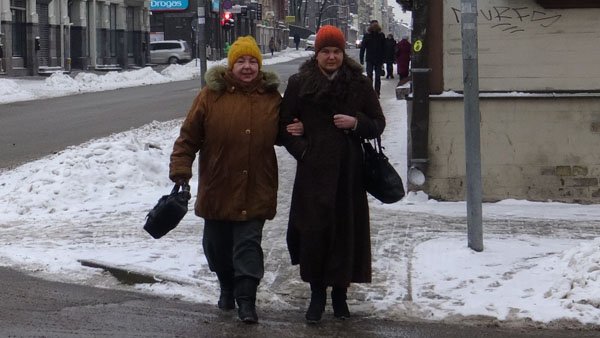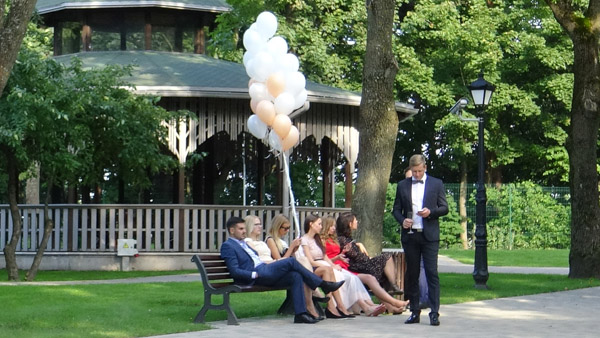The mainstream attire of urban Latvians increasingly replicates that of the Western Europe and it is acquired in the same franchises (opened ~2000s).
The richest go to Milan and Paris to shop, while the small town “elite” visits main cities and famous local designers. The less well off shop at marketplaces and used clothing stores (where a good suit may be bought for less than 1 Euro if you know when to visit).
Seasonal clothing in Latvia
Major summer/winter temperature differences mean that Latvian street fashion is highly seasonal.
Summer clothing can be skimpy but it should still cover upper thighs and torso. Anything less than that is acceptable only for swimming and sunbathing. Being naked/topless is only common in nudist beaches/saunas, some of which are gender-segregated.

Spring/Autumn clothing is warmer, hands and face remaining the sole uncovered portions of the skin.
During wintertime Latvians throw in many layers of clothes to combat the frost: furs, scarfs, gloves, caps, socks… Most of these warmest clothes are removed while in heated interiors (at some institutions this is even mandatory), showing the usual Spring/Autumn clothing underneath.

Main clothing subcultures in Latvia
Parallel to the Western fashion trends Latvia has a more glitzy female fashion (more colors, shorter skirts, higher heels, more make-up), somewhat more popular in smaller towns and among the ethnic minorities. It dates to the 1990s when people were hungry for colors, glitz and less conservativeness (denied to them for decades by the Soviet regime).

People considering themselves to be more fashionable (i.e. imitating the West more closely) tend to denounce such “over-the-top” clothing. Male counterparts of such style typically emphasize their masculinity by extensive use of sportswear, even for a simple walk or a night out (prestigious nightclubs ban this). Muscles and cars are also parts of their image.
Other parts of Latvian youth have embraced Western subcultures since the 1990s, each with its own clothing aesthetics, preferred musical styles, and festivals. They include goths, hippies, punks, “metallists”, “street culture” (hip hop), skinheads, ultras and LGBT.
Fashion under the Soviet occupation
Modern glitz likely would have not become so popular if not the decades of clothing limitations under the Soviet occupation (1945-1990). Make-up for female school students and long hair for males used to be banned, for example.
Furthermore, there used to be a constant shortage of goods, including good clothes. There have been merely a few designs readily available (all conservative) – therefore most people of the same age dressed similarly. To avoid this most women used to knit and sew extensively well until the 1990s. Additionally, the few people privileged enough to be allowed abroad (especially to the non-communist states) used to shop there for their relatives (or buy goods for illegal resale).
Older women may still dress in Soviet style-clothes or knit/sew but these practices are much less common after the advent of independent Latvia and the free market.
Formal vs. informal clothing in Latvia
Under the Soviet occupation formal attire was required on many occasions, e.g. in theaters and restaurants, for students during all exams. New generations have largely adopted Western practices and there are less suits in streets. In fact, strict dress codes are less common in Latvia today than in the West.

Folk costume is acceptable as formal attire under the Latvian etiquette. However, today its usage is limited to folk singing and similar events. Prior to the 20th century, the folk costumes were used by most Latvian peasants; they are characterized by white shirt under a colorful jacket (exact patterns depending on region). Women wear long patterned skirts (shorter for folk dances), men use trousers. Women also cover their hair with scarfs.
Uniforms are uncommon: few schools have them and many jobs that tend to be uniformed elsewhere (e.g. bus driver) allow workers to dress freely.
